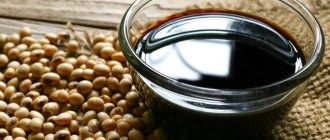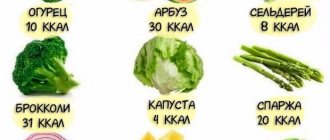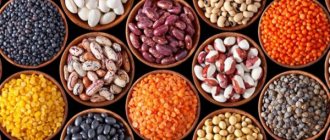For vegetarians, vegans, and those who avoid or are allergic to dairy, soy protein often serves as the primary source of this important nutrient.
However, soy is a somewhat controversial product.
While some think of soy as a nutritious food, others consider it a health enemy.
In this article, we'll look at the science behind whether soy protein is good for your body or whether it can harm you.
Soy protein - benefits or harm for the body of women and men
Nutritional value and composition
Soy protein isolate is made from defatted soy flakes that have been washed with either alcohol or water to remove sugars and fiber. They are then dehydrated and turned into powder.
This product is very low in fat and contains no cholesterol.
Soy protein powder is used to make soy formula for infants and to produce a variety of meat and milk alternative products.
28 grams of soy protein isolate contains (% of recommended daily intake) ():
- Calorie content: 95 kcal (5%).
- Carbohydrates: 2.1 g (1%).
- Fat: 0.9 g (1%).
- Fiber: 1.6 g (6%).
- Protein: 22.6 g (45%).
- Folate: 49.3 mcg (12%).
- Choline: 53.5 mg.
- Calcium: 49.8 mg (5%).
- Iron: 4.1 mg (23%).
- Phosphorus: 217 mg (22%).
- Sodium: 281 mg (12%).
- Zinc: 1.1 mg (8%).
- Copper: 0.4 mg (22%).
- Manganese: 0.4 mg (21%).
- Omega-3 fatty acids: 54.6 mg.
- Omega-6 fatty acids: 407 mg.
While soy protein isolate powder is a concentrated source of protein, it also contains phytates, which can reduce mineral absorption.
Summary:
Soy protein is a good source of plant protein and contains many different important nutrients. However, they also contain phytates, which reduce the absorption of minerals.
Application
Soy meat is used in cooking and is an instant product. Dry soy meat is usually simply boiled - the fibers of the meat swell, and the mass of the product doubles. This product can be either boiled in broth or soaked in a marinade. Soy meat has a less rich flavor than natural meat, so it is better to add spices when cooking. It is used to prepare various dishes as an analogue of meat, and is not recommended for consumption by pregnant women, as well as people suffering from kidney and liver disease.
Market Analytics
- Black Lives Matter movement: reaction and consequences for the beauty industry
- COVID-19 is changing the rules of the game in the cosmetics market
- Beauty of the future: cosmetic innovations 2020
Convenient search for beauty salons on our website
Beauty salons in Moscow Beauty salons in St. Petersburg Beauty salons in Ekaterinburg Beauty salons in Novosibirsk
Latest blog posts on our website
- Naturecream / Apricot kernel oil for face
- Naturecream / MATRIXYL3000 - the best skin elasticity stimulator
- Naturecream / SPF in Natural Oils
- Naturecream / Geranium (Pelargonium) oil for skin health and beauty
- Prostye-sovety / Save on a beauty salon: procedures that can be done at home
- Naturecream / Growth Factor - brings back youth?
- Oksana-Lezina / 3 effective abdominal exercises from a fitness instructor for beginners
- Prostye-sovety / Making perfect curls at home
- Prostye-sovety / Which hair removal method to choose
- Naturecream / Wrinkles Puppets
Latest forum topics on our website
- Natalya / How to properly make a gelatin mask?
- Mrs._Smith / Badly sunburned! What to do?((
- Ice / Is it necessary to combine fitness classes with a diet?
- Antonova / What can be used for hair loss?
- Radio operatorKat / Who was on a protein diet?
Other articles in this section
| Shoulder of lamb Shoulder of lamb is quality meat from the front leg of domestic sheep (ram). Man began sheep farming approximately eight thousand years ago in the territories of Turkey, Syria, and Iraq. Mutton is the meat of a young lamb (one-year-old ram or sheep). It is highly valued for its interesting taste and many beneficial properties. In Russia, the Kalmyk meat breed of sheep is highly valued - it is the richest in vitamins and minerals. |
| Boiled lean beef Beef is one of the most healthy types of meat, recommended for dietary nutrition. The protein contained in this meat is completely digestible. There are three types of beef. The quality of meat directly depends on the feed, age and sex of the livestock. Beef is a dietary, low-fat and very nutritious meat that should and can be eaten by those who are concerned about their health. |
| Boiled beef Beef has long been considered one of the most popular types of meat, since this meat is very tasty and contains useful vitamins and elements. The quality of beef itself often depends on the age of the animal. It can be soft and tender (if it was a young calf), or a little hard and tough (if the animal was more mature). |
| Roasted lean beef For a person who cares about their health, this dish is extremely healthy. The erroneous connection of it with a church post misleads many. This is a dietary low-fat dish prepared strictly according to the recipe. There is an opinion that if a person decides to go on a diet, then meat should be excluded from the diet. This is a misconception because... Beef is not only necessary, but also healthy. In particular, this is beef tenderloin, which does not contain fatty layers. |
| Capercaillie The capercaillie is the largest bird of the order Galliformes; its size almost reaches the size of a turkey. This bird is very popular among hunters, as it is considered a valuable prey. In the spring, male capercaillie very often become vulnerable due to the onset of their mating season and therefore can be easily caught. The habitat of wood grouse is mixed forests. In Russia, due to the cutting down of trees, the population of this bird has decreased, and now it lives only in the northern regions of Russia. Wood grouse can also be found in Asia Minor, in the mountains of the Alps, Carpathians, Spain and Greece. The weight of wood grouse ranges from 1.5 to 4 kg. Males are dark or brown in color, while females are reddish with speckles. |
| Pork tongue Since ancient times, meat has been part of the daily human diet. Pork is very popular in many countries around the world. And dishes made from pork tongue are considered a special delicacy. |
| Beef goulash Goulash came into our lives thanks to the Hungarian shepherds, where this dish is considered national. Beef or veal meat was cooked over fires in a cauldron with the addition of vegetables and spices. The word “goulash” comes from the Hungarian “guyash”, which means “shepherd”. Hungarian chefs claim that only those cooked over an open fire in the fresh air can be considered real goulash. But no matter what they say, everyone knows that good goulash cannot be spoiled even by cooking in an ordinary kitchen! The Linear Cossacks believe that goulash should be prepared from the most tender kidney part of a beef carcass, because... This part is prepared quickly, which is explained by the Cossack way of life. |
| Pork loin, b/c In Russia, pork loin, b/c, is usually called a cut from the back of pork. This is the most nutritious meat; it has no fatty layers. The meat is very tasty, soft, and easy to cook. In stores, the highest demand is for the back of the pig. |
| Veal lungs Veal lungs are one of the most healthy and dietary offal, which is very popular in Asian and Eastern countries. The main advantage of lungs over meat is their low fat content and excellent absorption by the body. This by-product has almost no contraindications, and nutritionists advise including it in the diet of overweight people. The most useful and tasty lung is young calves aged 3-4 months. |
| Turkey (heart) Turkey hearts have excellent nutritional and taste qualities. They are based on muscle tissue with thin fibers and a dark red color. There is a small layer of fat, which is white in these hearts only on the upper part. It must be removed just before the cooking process. They themselves are much denser than chicken. Their size is also much larger. |
Helps build muscle
Unlike most other plant proteins, soy protein is a complete protein.
This means that it contains all the essential amino acids that the body cannot produce and must be obtained from food.
While every amino acid plays a role in muscle protein synthesis, branched chain amino acids (BCAAs) are the most important when it comes to building muscle (,).
One study found that people who drank 5.6 grams of BCAAs after a resistance workout had a 22% increase in muscle protein synthesis, compared to people who received a placebo ().
Specifically, the BCAA leucine promotes muscle protein synthesis and helps build muscle (,).
Compared to whey and casein proteins, soy protein falls somewhere in the middle when it comes to muscle protein synthesis.
One study found that soy protein was inferior to whey protein for muscle protein synthesis but performed better than casein. The researchers concluded that this may be related to the rate of digestion or leucine content ().
Likewise, a review study found that whey protein supported muscle protein synthesis better than soy protein in young and older adults ().
Interestingly, soy may benefit you best when combined with other proteins.
Some research suggests that combining milk and soy proteins may result in greater muscle protein synthesis than whey, casein, or soy proteins alone ().
Summary:
Although soy protein contains the BCAA leucine and does increase muscle protein synthesis to some extent, it appears to be inferior to whey protein in terms of muscle building.
Soy protein[edit | edit code]
Boris Tsatsouline. Soy texture.
Yuzhakov Anton Digestibility, digestibility and biological value of soybeans from 10:16
Soy protein
- according to research, the worst type of protein to use in bodybuilding, both when gaining muscle mass and when burning fat. It has a very low cost and is widely used for feeding livestock. For economic reasons, it is actively advertised and also included in products and sports nutrition, so always read the composition carefully. Soy protein has low popularity and, according to most experts, should not be used for the following reasons (relevant for isolates and concentrates):
- Low biological value (74).
- Incomplete amino acid composition
- Low absorption rate.
- Potential estrogenic activity (absent in isolates).
- In a number of studies below, soy protein was found to be inferior to other types of protein.
Biological value[edit | edit code]
There are many different types of protein available today. Efficiency is measured by such an indicator as biological value (BC). BC is the most accurate indicator of the biological and anabolic activity of a protein. The index of biological value of protein is calculated as the ratio of the amount of nitrogen remaining in the body to the amount of nitrogen obtained from a given protein, i.e. its digestibility is taken into account. Biological value of different types of protein:
- Whey - 130
- Whole egg - 100
- Egg white – 88
- Casein - 77
- Soy
— 73
May help you lose weight
Research shows that high-protein diets can lead to weight loss, even without restricting calorie or nutrient intake (, ,).
However, evidence is mixed regarding the relationship between soy protein and weight loss.
Some studies show that soy protein may increase weight loss as effectively as animal proteins.
In one study, 20 obese men ate both a high soy protein diet and a high meat protein diet ().
Appetite control and weight loss were similar in both groups. The researchers concluded that diets high in soy protein were as effective in weight loss as diets high in animal protein.
Another 12-week study showed similar results using soy protein powder. Participants received either a soy-based or non-soy-based meal replacement. By the end of the study, both resulted in an average weight loss of 7.8 kg (7.8 kg).
In fact, one study of people with diabetes and obesity found that meal replacement with soy protein shakes may be more effective than standard diets for weight loss ().
Those who replaced meals with soy protein lost an average of 2 kg more than those who followed a standard diet.
However, although some studies have observed effects on reducing excess body weight, a review of 40 studies assessing the effects of soy protein on weight, waist circumference and fat mass found no significant beneficial effects ().
Overall, the evidence for soy protein intake for weight loss is not as strong as the evidence for other proteins such as whey and casein (, ).
Summary:
Some research suggests that soy protein may be effective in losing weight, but the evidence is mixed and does not show it is more effective than other proteins.
Benefit for health
Some research suggests that including soy protein in your diet may provide a variety of health benefits.
For example, soy products have a positive effect on heart health. In a review of 35 studies, soy consumption lowered levels of "bad" LDL cholesterol and increased levels of "good" HDL cholesterol ().
Another review found that replacing animal protein with 25 grams or more of soy protein resulted in reductions in total cholesterol, "bad" LDL cholesterol, and triglycerides ().
For cancer, the evidence appears mixed.
In many observational studies, a diet high in soy has been associated with a protective anticancer effect.
However, the scientists note that it remains unknown whether this refers to soy protein isolate powder or other plant protein derived from soybeans.
Some observational and case-controlled studies have linked soy consumption to a reduced risk of breast cancer (, ,).
Others have found no effect in preventing the risk of developing breast cancer. In one study, soy consumption was even linked to stimulating rapid cell production in the breasts of premenopausal women, possibly increasing the potential risk of developing breast cancer (, ).
Regarding the health effects of soy protein on men, some observational studies suggest that consuming soy products may reduce the risk of prostate cancer in older men (, ).
Although results from observational studies are encouraging, human clinical studies regarding the potential protective anticancer effect of soy are currently inconclusive.
Additionally, many studies have been conducted using soy products rather than soy protein powder.
However, soy protein can be a good source of plant protein for people who do not consume animal proteins, including vegetarians and vegans, allowing them to benefit from consuming this nutrient ().
Summary:
Soy products may have potential health benefits, such as lowering cholesterol and possibly reducing the risk of cancer, but more research is needed.
What are the benefits of soybeans?
It is an excellent basis for weight loss, because it combines complete protein compounds and a small amount of saturated fatty acids, which is typical for meat and dairy products. Numerous beneficial properties of soy are due to the substances it contains:
- Phospholipids. They regenerate cell membranes, normalize the ability of liver cells to detoxify, and act as antioxidants. Additionally, phospholipids reduce the need for insulin in diabetics and improve thinking.
- Lecithin. Stimulates metabolism, cholesterol and fat metabolism, and together with choline helps the liver burn excess fat deposits faster. In addition, lecithin has choleretic and lipotropic effects.
- Polyunsaturated fatty acids. They prevent cholesterol from accumulating in the walls of blood vessels, which prevents atherosclerosis.
- Tocopherol. A high level of this component strengthens the body's defenses, increases potency and slows down the aging process.
Possible harm
Some people have problems with soy.
As mentioned, soy protein contains phytates, also known as anti-nutrients. They interfere with the absorption of minerals in your gastrointestinal tract (,).
There is also some concern that soy consumption may affect a person's thyroid function.
The isoflavones in soy function as goitrogens, which can affect thyroid function and hormone production (, ).
However, there are many studies that show that soy has no or only a very slight effect on thyroid function in humans (, , ).
Additionally, many people choose to avoid soy protein because of the phytoestrogens it contains, as there are concerns that phytoestrogens may disrupt the body's natural hormone levels.
Phytoestrogens are chemical compounds that occur naturally in plants and have estrogen-like properties. Soy is a significant source of phytoestrogens ().
However, soy protein powder is made from soybeans that have been washed with alcohol and water, which eliminates a significant portion of the phytoestrogens contained (,).
This is also why many men fear that soy protein may lower testosterone levels, but research does not support this claim.
A large observational study found that neither soy products nor soy isoflavone supplements altered testosterone levels in men ().
Many of the potential downsides of soy come from consuming soy in general, not just soy protein powder. More research is needed to see how soy protein affects health.
Summary:
Although there are some potential downsides to consuming soy protein, the evidence is fairly weak and suggests that most people can consume soy products without problems.
Summarize
- Soy protein is a complete source of protein. It can help build muscle, but is not as good as whey protein.
- In general, soy is safe for most people and may provide health benefits, including weight loss.
- If you like the taste or prefer plant-based foods, you might want to try soy protein.
Tags: Protein, Soy
- Related Posts
- Magnesium: why the body needs it, what foods it contains
- 9 Best Supplements for the Keto Diet
- Vitamin B6: properties, uses, where it is found, side effects
« Previous entry











